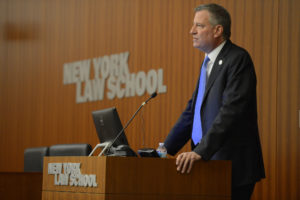
Mayor Bill de Blasio. Image credit: CityLaw.
Mayor’s new homelessness plan includes broad reforms in current systems and the replacement of 360 shelter cluster sites with 90 new shelters citywide. On February 28, 2017, the Mayor’s Office released a 128-page report entitled “Turning the Tide on Homelessness.” The report outlines the steps the administration will take going forward to better combat the rising homeless crisis in New York City.
Chiefly among the reforms, the administration intends to end the use of 360 cluster sites and commercial hotel facilities currently used by the Department of Homeless Services. Those sites will be replaced by 90 traditional shelters distributed throughout the five boroughs. The plan would also upgrade existing shelters to provide more services.
Also included in the administration’s plan are improvements to the City’s rental assistance programs to better provide access to affordable housing and prevent illegal evictions. The plan outlines several steps to this effect, including the streamlining of the rental assistance program to improve the program’s effectiveness and efficiency.
The report also referenced the administration’s pledge to provide an additional $93 million to grant universal access to legal services for tenants facing eviction in Housing Court. The funds will effectively double the existing fund for Housing Court legal services and service an estimated 400,000 New Yorkers every year. CityLand previously covered this announcement here.
The administration is also piloting a requirement that owners of buildings benefiting from the expired 421-a tax exemption make apartments available to families referred by the HRA and DHS. The referred households must meet the building’s income requirements. The administration estimates that up to 5 percent of a 421-a building’s apartments could provide housing options for formerly homeless households from that community.
The HRA will also form a Source of Income Discrimination Unit to prevent and prosecute housing discrimination by landlords with buildings of six or more units based who refuse to lease to tenants using government assistance to pay part of the rent. The new unit will intervene on behalf of tenants with the goal of getting them an apartment and will provide legal advice, consultation and guidance to other City agencies and community advocates. The unit will focus on filing and prosecuting complaints that allege a pattern and practice of source of income discrimination in State Supreme Court.
“Our plan will continue to bring more people off the streets, reduce the number of shelter sites by almost half, while strengthening services and keeping homeless New Yorkers closer to the supports they need to help them get back on their feet,” said Mayor Bill de Blasio. “It will take a united effort and the help of many New Yorkers, but together will turn the tide of homelessness.”
Several other elected officials expressed support for the administration’s plan, including several State Assembly Members and City Council Members. “I applaud Mayor de Blasio and Commissioner Banks for their efforts to help stem the tide of homelessness in our city. I look forward to working together to ensure that we provide these individuals and families with necessary resources to lead them on a path towards self-sufficiency,” said Assembly Member Andrew Hevesi, Chairman of the Assembly Committee on Social Services.
“At this pivotal moment when we are seeing a plateau in the shelter population, we have the opportunity to make a real impact on the future of homelessness in our neighborhoods. Government and community leaders alike must acknowledge the collective responsibility to choose compassion and ensure that all New Yorkers have a place to call home,” said Council Member Stephen Levin, Chair of the General Welfare Committee.
“The de Blasio administration is adapting to the needs of the homeless population in our city, taking this issue head-on,” said Council Member Ydanis Rodriguez. “We know how tough it is when it comes to siting homeless shelters, but this is administration is seeking to be open with communities about needs and intentions so that all are helping our most vulnerable residents. We cannot tackle the problem of homelessness without a holistic approach that tackles poverty at the same time as housing.
By: Jonathon Sizemore (Jonathon is the CityLaw Fellow and a New York Law School Graduate, Class of 2016).

